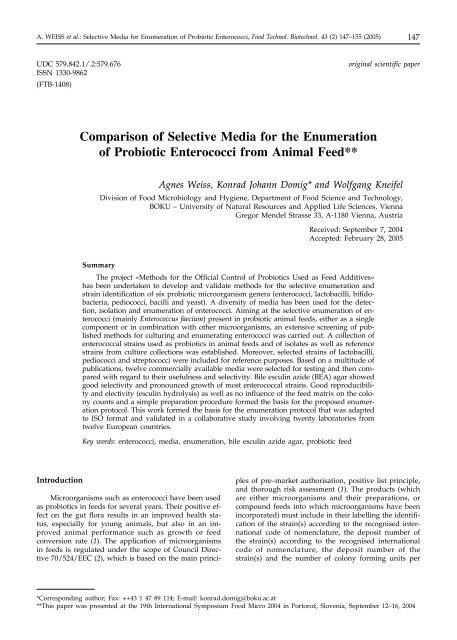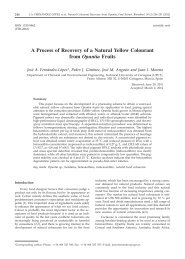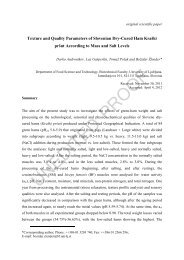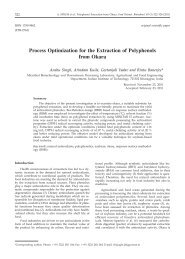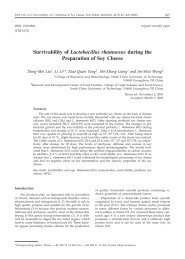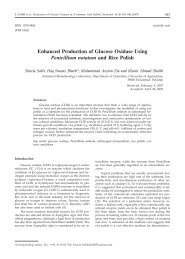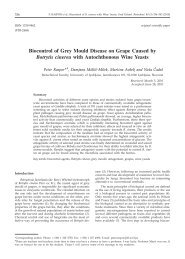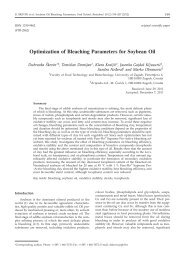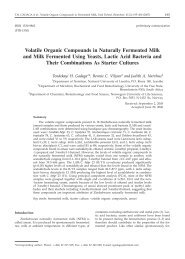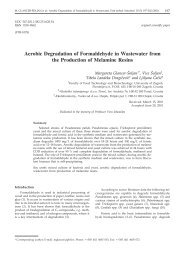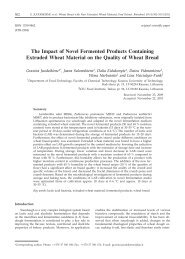Comparison of Selective Media for the Enumeration of - Food ...
Comparison of Selective Media for the Enumeration of - Food ...
Comparison of Selective Media for the Enumeration of - Food ...
You also want an ePaper? Increase the reach of your titles
YUMPU automatically turns print PDFs into web optimized ePapers that Google loves.
A. WEISS et al.: <strong>Selective</strong> <strong>Media</strong> <strong>for</strong> <strong>Enumeration</strong> <strong>of</strong> Probiotic Enterococci, <strong>Food</strong> Technol. Biotechnol. 43 (2) 147–155 (2005)147UDC 579.842.1/.2:579.676ISSN 1330-9862(FTB-1408)original scientific paper<strong>Comparison</strong> <strong>of</strong> <strong>Selective</strong> <strong>Media</strong> <strong>for</strong> <strong>the</strong> <strong>Enumeration</strong><strong>of</strong> Probiotic Enterococci from Animal Feed**Agnes Weiss, Konrad Johann Domig* and Wolfgang KneifelDivision <strong>of</strong> <strong>Food</strong> Microbiology and Hygiene, Department <strong>of</strong> <strong>Food</strong> Science and Technology,BOKU – University <strong>of</strong> Natural Resources and Applied Life Sciences, ViennaGregor Mendel Strasse 33, A-1180 Vienna, AustriaReceived: September 7, 2004Accepted: February 28, 2005SummaryThe project »Methods <strong>for</strong> <strong>the</strong> Official Control <strong>of</strong> Probiotics Used as Feed Additives«has been undertaken to develop and validate methods <strong>for</strong> <strong>the</strong> selective enumeration andstrain identification <strong>of</strong> six probiotic microorganism genera (enterococci, lactobacilli, bifidobacteria,pediococci, bacilli and yeast). A diversity <strong>of</strong> media has been used <strong>for</strong> <strong>the</strong> detection,isolation and enumeration <strong>of</strong> enterococci. Aiming at <strong>the</strong> selective enumeration <strong>of</strong> enterococci(mainly Enterococcus faecium) present in probiotic animal feeds, ei<strong>the</strong>r as a singlecomponent or in combination with o<strong>the</strong>r microorganisms, an extensive screening <strong>of</strong> publishedmethods <strong>for</strong> culturing and enumerating enterococci was carried out. A collection <strong>of</strong>enterococcal strains used as probiotics in animal feeds and <strong>of</strong> isolates as well as referencestrains from culture collections was established. Moreover, selected strains <strong>of</strong> lactobacilli,pediococci and streptococci were included <strong>for</strong> reference purposes. Based on a multitude <strong>of</strong>publications, twelve commercially available media were selected <strong>for</strong> testing and <strong>the</strong>n comparedwith regard to <strong>the</strong>ir usefulness and selectivity. Bile esculin azide (BEA) agar showedgood selectivity and pronounced growth <strong>of</strong> most enterococcal strains. Good reproducibilityand electivity (esculin hydrolysis) as well as no influence <strong>of</strong> <strong>the</strong> feed matrix on <strong>the</strong> colonycounts and a simple preparation procedure <strong>for</strong>med <strong>the</strong> basis <strong>for</strong> <strong>the</strong> proposed enumerationprotocol. This work <strong>for</strong>med <strong>the</strong> basis <strong>for</strong> <strong>the</strong> enumeration protocol that was adaptedto ISO <strong>for</strong>mat and validated in a collaborative study involving twenty laboratories fromtwelve European countries.Key words: enterococci, media, enumeration, bile esculin azide agar, probiotic feedIntroductionMicroorganisms such as enterococci have been usedas probiotics in feeds <strong>for</strong> several years. Their positive effecton <strong>the</strong> gut flora results in an improved health status,especially <strong>for</strong> young animals, but also in an improvedanimal per<strong>for</strong>mance such as growth or feedconversion rate (1). The application <strong>of</strong> microorganismsin feeds is regulated under <strong>the</strong> scope <strong>of</strong> Council Directive70/524/EEC (2), which is based on <strong>the</strong> main principles<strong>of</strong> pre–market authorisation, positive list principle,and thorough risk assessment (1). The products (whichare ei<strong>the</strong>r microorganisms and <strong>the</strong>ir preparations, orcompound feeds into which microorganisms have beenincorporated) must include in <strong>the</strong>ir labelling <strong>the</strong> identification<strong>of</strong> <strong>the</strong> strain(s) according to <strong>the</strong> recognised internationalcode <strong>of</strong> nomenclature, <strong>the</strong> deposit number <strong>of</strong><strong>the</strong> strain(s) according to <strong>the</strong> recognised internationalcode <strong>of</strong> nomenclature, <strong>the</strong> deposit number <strong>of</strong> <strong>the</strong>strain(s) and <strong>the</strong> number <strong>of</strong> colony <strong>for</strong>ming units per*Corresponding author; Fax: ++43 1 47 89 114; E-mail: konrad.domig@boku.ac.at**This paper was presented at <strong>the</strong> 19th International Symposium <strong>Food</strong> Micro 2004 in Portoro`, Slovenia, September 12–16, 2004
148 A. WEISS et al.: <strong>Selective</strong> <strong>Media</strong> <strong>for</strong> <strong>Enumeration</strong> <strong>of</strong> Probiotic Enterococci, <strong>Food</strong> Technol. Biotechnol. 43 (2) 147–155 (2005)gram, provided that it is measurable by an <strong>of</strong>ficial orscientifically valid method (3). Due to <strong>the</strong> importance <strong>of</strong>enterococci in different foods, feeds, clinical and environmentalsamples, numerous media have been used <strong>for</strong><strong>the</strong> detection, isolation and enumeration (4). This studywas per<strong>for</strong>med within an EU project initiated by a DedicatedCall and was based on <strong>the</strong> regulations <strong>of</strong> <strong>the</strong>Council Directive 70/524/EEC (2) concerning additivesin feeds and <strong>the</strong> application <strong>of</strong> probiotics in feeds. Accordingto <strong>the</strong> Official Journal <strong>of</strong> <strong>the</strong> European CommunitiesC 263/3 (5), eleven genera <strong>of</strong> bacteria, three genera<strong>of</strong> yeast and one mould have been approved <strong>for</strong>temporary use within specified member states and arein line with <strong>the</strong> provisions <strong>of</strong> Council Directive 93/113/EC (3).Twelve media were selected based on a literaturesearch (4) and tested with a set <strong>of</strong> strains. The specieswere selected based on <strong>the</strong>ir involvement in probioticanimal feeds as outlined in <strong>the</strong> Official Journal <strong>of</strong> <strong>the</strong>European Communities C 263/3 (5).Material and MethodsTest strainsThe strain set used <strong>for</strong> <strong>the</strong> selectivity test consisted<strong>of</strong> twenty-eight enterococci, eleven lactobacilli, six pediococciand one Streptococcus <strong>the</strong>rmophilus strain (seeTable 1). Lactobacilli, pediococci and S. <strong>the</strong>rmophilus werechosen as <strong>the</strong>y are authorised by <strong>the</strong> EU to be incorporatedin feeds, and are so closely related to enterococcithat <strong>the</strong>y might interfere with <strong>the</strong>ir enumeration.Culturing <strong>of</strong> test strainsThe test strains used were subcultured as follows:enterococci were grown in 10 mL <strong>of</strong> brain heart infusionbroth (BHI, CM 225, Oxoid) under aerobic conditions<strong>for</strong> 24 h at 37 °C. Lactobacilli were grown in MRS broth(1.10661, Merck) under anaerobic conditions (anaerobicchamber; atmosphere: N 2 80 %, CO 2 10 % and H 2 10 %)<strong>for</strong> 24 h at 37 °C. Trypticase soy broth (TS, CM 129, Oxoid)supplemented with 3 g/L <strong>of</strong> yeast extract (1.037753,Merck) was used <strong>for</strong> subculturing <strong>of</strong> <strong>the</strong> S. <strong>the</strong>rmophilusstrain under anaerobic conditions at 32 °C <strong>for</strong> 24 h and<strong>for</strong> pediococci under <strong>the</strong> same conditions <strong>for</strong> 48 h.<strong>Selective</strong> mediaThe tested selective media were prepared accordingto <strong>the</strong> author’s or manufacturers’ guidelines. After sterilisation<strong>the</strong> media were cooled to 50 °C and plates wereprepared by pouring 17 mL <strong>of</strong> sterile medium into a sterilePetri dish. All media used are described below, includingimportant details <strong>of</strong> <strong>the</strong>ir preparation.Bile esculin (BE) agar (CM 888, Oxoid; 44.5 g/L),which was autoclaved <strong>for</strong> 15 min at 121 °C, was applied.Additionally, two bile esculin azide (BEA) agarsfrom different manufacturers were tested: enterococcosel(ECSA) agar (4312205, Becton-Dickinson; 56 g/L,which was autoclaved <strong>for</strong> 15 min at 121 °C) and D-coccosel(D-Cocc) agar (51025, bioMérieux; 56 g/L, whichwas autoclaved <strong>for</strong> 15 min at 121 °C).Table 1. List <strong>of</strong> test strainsStrain Code Genus – species – subspecies O<strong>the</strong>r codeEn1 Enterococcus faecalis DSM 2570En2 E. faecalis DSM 20478En3 E. faecium DSM 2918En4 E. faecium DSM 20477En5 E. durans DSM 20633En6 E. gallinarum DSM 20628En7 E. faecium Own isolateEn8 E. faecium Own isolateEn9 E. faecium Own isolateEn10 E. faecium Own isolateEn11 E. faecium DSM 3320En12 E. faecalis DSM 2981En12A E. faecalis ATCC 14506En13 E. durans ATCC 6056En14 E. faecium ATCC 27270En15 E. faecalis ATCC 27274En16 E. faecium DSM 2146En17 E. faecium DSM 6177En18 E. avium DSM 20679En19 E. casseliflavus DSM 20680En20 E. hirae DSM 20160En21 E. malodoratus DSM 20681En22 E. mundtii DSM 4838En23 E. raffinosus DSM 5633En24 E. faecium DSM 7134En25 E. faecium NCIMB 10415En26 E. faecium NCIMB 11181En27 E. faecium NCIMB 30096En28 E. faecium Own isolateEn30 E. faecium ATCC 19434Lb1 Lactobacillus acidophilus DSM 20079Lb7 L. amylovorus DSM 20531Lb12 L. rhamnosus DSM 20021Lb13 L. reuteri DSM 20016Lb14 L. plantarum Own isolateLb17 L. fermentum ATCC 9338Lb20 L. casei Own isolateLb21 L. reuteri Own isolateLb22 L. casei DSM 20011Lb23 L. plantarum DSM 20174Lb28 L. rhamnosus DSM 7133Sc1 Streptococcus <strong>the</strong>rmophilus DSM 20617Pd1 Pediococcus acidilactici DSM 20248Pd2 P. acidilactici DSM 20238Pd3 P. damnosus DSM 20331Pd4 P. parvulus DSM 20332Pd5 P. dextrinicus DSM 20335Pd6 P. pentosaceus DSM 20336Pd7 P. pentosaceus ATCC 43200Pd8 P. inopinatus DSM 20285
A. WEISS et al.: <strong>Selective</strong> <strong>Media</strong> <strong>for</strong> <strong>Enumeration</strong> <strong>of</strong> Probiotic Enterococci, <strong>Food</strong> Technol. Biotechnol. 43 (2) 147–155 (2005)149Cephalexin aztreonam arabinose (CAA) agar (accordingto Ford et al. (6)) consists <strong>of</strong> Columbia agar base40 g/L, arabinose 10 g/L and phenol red solution 3.6mL/L, m/V=2. The pH value was adjusted to pH=7.8and <strong>the</strong> medium was autoclaved <strong>for</strong> 20 min at 114 °C(0.7 bar). After <strong>the</strong> medium had reached 50 °C, freshsterile solutions <strong>of</strong> aztreonam and cephalexin were addedto reach <strong>the</strong> final concentrations <strong>of</strong> 75 and 50 mg/L,respectively.Chromocult enterococci (CE) agar (1.10294, Merck;Chromocult enterococci broth 18 g/L and agar 14 g/L)was autoclaved <strong>for</strong> 15 min at 121 °C.Citrate azide Tween carbonate (CATC) agar (1.10279,Merck; 56 g/L) was autoclaved <strong>for</strong> 15 min at 121 °C.When <strong>the</strong> medium had reached approximately 50 °C,filter-sterilised solutions were added: 20 mL <strong>of</strong> sodium--hydrogen carbonate m/V=10, 10 mL <strong>of</strong> 2,3,5-triphenyltetrazolium chloride (TTC) solution m/V=1 and 4 mL <strong>of</strong>sodium azide solution m/V=10.mE (mE) agar (0333-17, Difco; 72.1 g/L) was autoclavedat 121 °C <strong>for</strong> 15 min. When <strong>the</strong> medium hadreached a temperature <strong>of</strong> approximately 50 °C, filter--sterilised solutions were added: 15 mL <strong>of</strong> TTC m/V=1and 0.24 g <strong>of</strong> nalidixic acid.Fluorescent gentamicin thallous carbonate (fGTC)agar (according to Littel and Hartman (7)) was obtainedby suspending CASO agar 40 g, potassium-dihydrogenphosphate5 g, amylose azure 3 g, galactose 1 g, thalliumazure 0.5 g, 4-methyl umbelliferyl-a-D-galactoside100 mg and 0.75 mL <strong>of</strong> Tween ® 80in1L<strong>of</strong>distilled waterand mixing thoroughly. Then 2.5 mL <strong>of</strong> gentamicinsolution (1 mg/mL) were added and autoclaved <strong>for</strong> 15min at 121 °C. When <strong>the</strong> medium had reached a temperature<strong>of</strong> approximately 55 °C, 20 mL <strong>of</strong> filter-sterilisedsodium hydrogen carbonate solution (m/V=10) wereadded.Kanamycin esculin azide (KEA) agar (CM 591, Oxoid;42.6 g/L) was obtained by adding two vials <strong>of</strong> kanamycinsupplement (SR92, Oxoid), and <strong>the</strong>n autoclaved <strong>for</strong>15 min at 121 °C.KF-streptococcus (KF) agar (CM 701, Oxoid; 76.4g/L) was autoclaved at 121 °C <strong>for</strong> 10 min. When <strong>the</strong>medium had reached 50 °C, 10 mL <strong>of</strong> filter-sterilisedTTC solution (m/V=1) were added.Membrane-filter enterococcus selective (SB) agar(according to Slanetz and Bartley (8); 1.05289, Merck;41.5 g/L) was sterilised by heating in a current <strong>of</strong> steamin an autoclave without excess pressure <strong>for</strong> 20 min.When <strong>the</strong> medium had cooled to approximately 50 °C,10 mL <strong>of</strong> filter-sterilised TTC (m/V=1) were added.Merckoplate Barnes (BA) agar (13576, Merck; ready--to-use plates) was used.Oxolonic acid esculin azide (OAA) agar (accordingto Audicana et al. (9)) was obtained by suspending 42.6g <strong>of</strong> kanamycin esculin azide agar (CM 591, Oxoid) and0.25 g <strong>of</strong> sodium azide in 1 L and <strong>the</strong>n autoclaved <strong>for</strong> 15min at 121 °C. Oxolonic acid (0.1 g) was dissolved in 5mL <strong>of</strong> 0.1 M NaOH and filter-sterilised. The aliquots <strong>of</strong><strong>the</strong> solution (1 mL <strong>of</strong> each) were stored at –20 °C. When<strong>the</strong> medium had reached a temperature <strong>of</strong> approximately45 °C, 0.5 mL <strong>of</strong> oxolonic acid solution wereadded under aseptic conditions.Sterile media in Petri dishes, protected against dehydration,were stored <strong>for</strong> up to two weeks at a temperature<strong>of</strong> 4 °C.Evaluation <strong>of</strong> selective mediaBased on a comprehensive literature review (4), <strong>the</strong>cited media were grouped according to <strong>the</strong>ir selectivecomponents. Already well-evaluated, mainly commerciallyavailable media were selected out <strong>of</strong> <strong>the</strong> maingroups to test <strong>the</strong>ir selectivity with a set <strong>of</strong> enterococciand strains <strong>of</strong> genera <strong>of</strong> o<strong>the</strong>r lactic acid bacteria. Thesubcultured strains were loop-streaked onto <strong>the</strong> agarplates. After incubation under aerobic conditions <strong>for</strong> 24h (BE, ECSA, D-Cocc, CAA, CATC, fGTC, KEA, SB, BA,OAA) or <strong>for</strong> 48 h (CE, mE, KF), <strong>the</strong> growth <strong>of</strong> <strong>the</strong> teststrains was evaluated. The colony size was measured(<strong>for</strong> parameters see Tables 2 and 3), <strong>the</strong>n <strong>the</strong> growthwas described, and digital photographs <strong>of</strong> <strong>the</strong> wholeplates and close ups (microscope SZH10, Olympus) <strong>of</strong>single colonies were taken (data not shown).Comparative testing <strong>of</strong> three selective mediaand BHI agarIn order to set up a protocol <strong>for</strong> <strong>the</strong> enumeration <strong>of</strong>enterococci in feeds and feed supplements, <strong>the</strong> threemost selective media (ECSA, mE and CATC) were chosenand included in fur<strong>the</strong>r trials. Their per<strong>for</strong>mancewas compared with <strong>the</strong> non-selective control mediumBHI concerning <strong>the</strong>ir productivity. The productivity wascalculated according to <strong>the</strong> following <strong>for</strong>mula:N ssP =N Nsss0/1/number <strong>of</strong> colonies <strong>of</strong> <strong>the</strong> sought type obtained onselective mediumsN 0 number <strong>of</strong> colonies <strong>of</strong> <strong>the</strong> sought type obtained oncontrol mediumFrom a liquid culture <strong>of</strong> <strong>the</strong> strain E. faecium En24(contained in <strong>the</strong> feed supplement »Provita – LE«) oneloop was transferred into sterile BHI broth, blended andincubated under aerobic conditions <strong>for</strong> 24 h at 37 °C. Avolume <strong>of</strong> 1 mL <strong>of</strong> this turbid broth was used to preparea single series <strong>of</strong> decimal dilutions up to <strong>the</strong> dilution <strong>of</strong>1:10 7 . The dilutions <strong>of</strong> 1:10 5 , 1:10 6 and 1:10 7 were used toinoculate plates <strong>of</strong> <strong>the</strong> tested selective media and BHI(two parallel plates per dilution) using <strong>the</strong> surface platingmethod. The inverted plates were incubated underaerobic conditions <strong>for</strong> 24 h at 37 °C. The colony-<strong>for</strong>mingunits (CFU) were determined right after <strong>the</strong> incubation.The arithmetic means <strong>of</strong> <strong>the</strong> colony counts <strong>of</strong> <strong>the</strong>plates with <strong>the</strong> optimum dilution (between 5 and 300colony-<strong>for</strong>ming units per plate) and <strong>the</strong> productivitieswere calculated. The experiment was repeated with modifications(mE agar was no more included, <strong>the</strong> dilutions<strong>of</strong> 1:10 6 , 1:10 7 and 1:10 8 were applied <strong>for</strong> inoculation,three plates were inoculated at <strong>the</strong> same time <strong>for</strong><strong>the</strong> dilution <strong>of</strong> 1:10 7 and two plates <strong>for</strong> each <strong>of</strong> <strong>the</strong> o<strong>the</strong>rdilutions).
150 A. WEISS et al.: <strong>Selective</strong> <strong>Media</strong> <strong>for</strong> <strong>Enumeration</strong> <strong>of</strong> Probiotic Enterococci, <strong>Food</strong> Technol. Biotechnol. 43 (2) 147–155 (2005)Table 2. Growth intensities <strong>of</strong> enterococci on tested mediaTested mediaTest strainsKEA OAA ECSA D-Cocc BE KF CATC SB BA mE CAA fGTC CEEn1 E. faecalis ++ ++ ++ ++ ++ ++ ++ + ++ ++ + ++ +En2 E. faecalis ++ ++ ++ ++ ++ ++/+++ ++ + ++ + ++ +++ +En3 E. faecium ++/+++ ++ ++ ++/+ ++ + + (+) (+) ++ (+) ++ ++En4 E. faecium ++ ++ ++ ++ ++ ++ ++/+ ++ ++/+ ++ ++ +++ +En5 E. durans + ++ + + ++ + (+) (+) (+) + ++/+ ++/+ +En6 E. gallinarum ++/+ ++/+ + + ++ + (+) (+) + + (+) +++ +En7 E. faecium ++/+++ ++ ++ ++ ++/+ ++/+ + + + ++ ++ +++ ++En8 E. faecium ++/+++ ++ ++ ++ ++ ++ + + + ++ (+) ++ ++En9 E. faecium ++ ++ ++ ++ ++/+++ +++ ++ + (+) ++ (+) ++ ++En10 E. faecium ++/+++ ++ ++ ++ ++ +++ ++ + (+) ++ + ++ ++En11 E. faecium ++/+++ ++ ++ ++ ++ +++ + ++ ++/+ + ++ ++ ++/+En12 E. faecalis ++/+++ ++ ++ ++ ++/+++ ++/+++ ++ + ++ ++/+ ++/+ ++/+++ ++En12A E. faecalis ++ ++ ++/+++ ++ ++/+++ ++/+++ +/(+) + ++ ++ ++ +++ ++En13 E. durans + + ++/+ + ++/+ + (+) +/(+) + + + ++ +En14 E. faecium ++ ++/+ ++/+ ++ + +++ + + ++/+ ++/+ + ++ +En15 E. faecalis +++ ++/+ ++/+++ ++ + ++ ++ + ++ ++ ++ ++ ++En16 E. faecium ++ ++ ++/+ ++ ++ +++ ++/+ + + ++/+++ (+) ++ ++/+En17 E. faecium ++ ++ ++ ++ ++ ++/+ ++/+ + + ++ ++ ++ ++/+En18 E. avium + + + + ++ + + +/(+) + + (+) ++ ++/+En19 E. casseliflavus ++/+ ++/+ + + ++ ++ + +/(+) + + (+) ++ +En20 E. hirae ++/+++ ++ ++ ++/+ ++ ++ + + ++/+ ++ ++ +++ ++/+En21 E. malodoratus (+) +/(+) + + + + (+) (+) + (+) (+) ++/+ +En22 E. mundtii ++ ++ ++ ++ ++/+ ++ (+) + ++ + (+) ++ ++/+En23 E. raffinosus ++/+ (+) (+) (+) ++/+ (+) (+) (+) (+) (+) + ++/+ +/(+)En24 E. faecium ++ +++ ++/+++ ++ ++ +++ + ++/+ ++/+ ++ ++/+ +++ ++/+++En25 E. faecium ++ ++ ++ ++ ++ ++ ++ ++ + ++ ++/+ ++ ++En26 E. faecium +++ ++/+++ + ++ ++ +++ ++ ++ ++/+ ++ ++/+ ++/+++ ++En27 E. faecium ++ ++ ++ ++ ++ ++ (+) ++ + ++ ++ ++ ++En28 E. faecium ++/+++ ++ + ++ ++ ++ + + ++/+ ++ (+) ++ ++/+Parameters used to describe <strong>the</strong> growth intensity <strong>of</strong> <strong>the</strong> tested strains: +++, large colonies, >1 mm in diameter; ++, medium size colonies, 1 mmin diameter; +, small colonies,
A. WEISS et al.: <strong>Selective</strong> <strong>Media</strong> <strong>for</strong> <strong>Enumeration</strong> <strong>of</strong> Probiotic Enterococci, <strong>Food</strong> Technol. Biotechnol. 43 (2) 147–155 (2005)151Table 3. Growth intensities <strong>of</strong> <strong>the</strong> o<strong>the</strong>r genera <strong>of</strong> lactic acid bacteria on <strong>the</strong> tested mediaTest strainsTested mediaKEA OAA ECSA D-Cocc BE KF CATC SB BA mE CAA fGTC CELb1 L. acidophilus – – – – – – – – (+) – – – –Lb7 L. amylovorus (+) – – – (+) – – – (–) – – (–) –Lb12 L. rhamnosus (+) – – – (+) – – – (+) – (+) (+) –Lb13 L. reuteri (+) + (+) (+) (+) (+) – (+) (+) – (+) – (+)Lb14 L. plantarum (+) – – – – – – – (+) – – (+) –Lb17 L. fermentum – – – – – – – – (+) – (+) (+) –Lb20 L. casei (+) – (+) – (+) – – – (–) – (+) (+) –Lb21 L. reuteri – – – – – – – – (–) – (+) – –Lb22 L. casei (+) (+) – – (+) (+) – – (–) – (+) (+) (+)Lb23 L. plantarum (+) + (+) (+) (+) + – (+) (+) (+) (+) (+) (+)Lb28 L. rhamnosus (+) – – – (+) – – – (+) – (+) (+) –Sc1 S. <strong>the</strong>rmophilus – – – – – – – – – – – (+) –Pd1 P. acidilactici (+) + (+) (+) (+) + – (+) (+) (+) (+) (+) (+)Pd2 P. acidilactici (+) + (+) (+) (+)/+ + – (+) (+) (+) (+) (+) (+)Pd3 P. damnosus – – – – – – – – (+) – (+) – –Pd4 P. parvulus (+) – (+) – (+) – – – (+) – (+) (+) –Pd5 P. dextrinicus (+) + (+) (+) (+) + – (+) (+) (+) (+) (+) (+)Pd6 P. pentosaceus (+) + (+) – (+) (+) – (+) (+) (+) (+) (+) (+)/+Pd7 P. pentosaceus (+) + (+) (+) (+) (+) – (+) (+) (+) (+) (+) (+)Pd8 P. inopinatus – – – – – – – – (+) – (+) – –Parameters used to describe <strong>the</strong> growth intensity <strong>of</strong> <strong>the</strong> tested strains: +++, large colonies, >1 mm in diameter; ++, medium size colonies, 1 mmin diameter; +, small colonies,
152 A. WEISS et al.: <strong>Selective</strong> <strong>Media</strong> <strong>for</strong> <strong>Enumeration</strong> <strong>of</strong> Probiotic Enterococci, <strong>Food</strong> Technol. Biotechnol. 43 (2) 147–155 (2005)Bile esculin (BE) agarOn bile esculin (BE) agar, enterococci grew as colonies<strong>of</strong> small to large size and white colour, only E. casseliflavusexhibited light brown and E. mundtii yellowpigmented colonies. The colonies <strong>of</strong> all strains were glistening.With <strong>the</strong> exception <strong>of</strong> E. avium, strong hydrolysis<strong>of</strong> esculin was observed. Seven strains <strong>of</strong> lactobacilli andsix strains <strong>of</strong> pediococci grew on BE medium. L. plantarumcould not be distinguished macroscopically fromenterococci, due to its ability to hydrolyse esculin andits small colony size.Bile esculin azide (ECSA) agarThis medium was one <strong>of</strong> <strong>the</strong> tested <strong>for</strong>mulations <strong>of</strong>bile esculin azide (BEA) agar. Most <strong>of</strong> <strong>the</strong> E. faeciumstrains grew on ECSA <strong>for</strong>ming medium to large size colonies.The colonies <strong>of</strong> E. casseliflavus were brown and<strong>the</strong> colonies <strong>of</strong> E. mundtii were yellow. All enterococciwith <strong>the</strong> exception <strong>of</strong> E. gallinarum exhibited strong hydrolysis<strong>of</strong> esculin. Three Lactobacillus and six Pediococcusstrains displayed minimal growth under <strong>the</strong> givenconditions. The strains L. plantarum, P. dextrinicus and P.pentosaceus, which showed strong hydrolysis <strong>of</strong> esculin,could be distinguished from enterococci by <strong>the</strong>ir colonysize.Bile esculin azide (D-Cocc) agarThis medium was <strong>the</strong> second <strong>of</strong> <strong>the</strong> tested <strong>for</strong>mulations<strong>of</strong> bile esculin azide (BEA) agar. Few enterococcishowed poor growth (small colonies), but most grew onD-coccosel agar as medium-sized colonies, exhibitingstrong hydrolysis <strong>of</strong> esculin. E. mundtii showed lightbrown colonies. Two strains <strong>of</strong> lactobacilli and fourstrains <strong>of</strong> pediococci were able to grow under <strong>the</strong> specifiedconditions, but did not hydrolyse esculin. Only L.plantarum exhibited strong esculin hydrolysis, and couldbe distinguished from enterococci by its colony size.Cephalexin aztreonam arabinose (CAA) agarOn CAA agar E. faecium grew as white colonies <strong>of</strong>pinpoint to medium size. E. mundtii displayed yellowpigmented colonies. For some enterococci acidificationwas observed. Growth was detected <strong>for</strong> eight strains <strong>of</strong>lactobacilli and seven strains <strong>of</strong> pediococci. They allgrew as pinpoint colonies, some exhibiting acidification.Enterococci, <strong>the</strong>re<strong>for</strong>e, could not be distinguished macroscopicallyfrom lactobacilli and pediococci on CAAmedium.Chromocult enterococci (CE) agarOn this agar all enterococci grew as blue colonies <strong>of</strong>pinpoint to large size. Three strains <strong>of</strong> lactobacilli andfive strains <strong>of</strong> pediococci exhibited growth on this medium.L. casei, L. plantarum, P. dextrinicus and two strains<strong>of</strong> P. pentosaceus could not be distinguished from enterococcimacroscopically.Citrate Tween carbonate azide (CATC) agarOn CATC medium, enterococci appeared as colonies<strong>of</strong> various sizes (pinpoint to medium) and colours(rosy to dark red). Only enterococci were able to growon this medium, but on account <strong>of</strong> <strong>the</strong> small colonysizes <strong>the</strong> plates were difficult to evaluate. Under <strong>the</strong>given test conditions, CATC medium displayed <strong>the</strong> bestselectivity.mE (mE) agarEnterococci grew as pinpoint to large size colonies<strong>of</strong> rosy to dark red colour on mE medium, some colonieswere thus too small <strong>for</strong> colony counting. The colonies<strong>of</strong> <strong>the</strong> type strains <strong>of</strong> E. durans and E. gallinarumwere surrounded by light red halos. The type strain <strong>of</strong>L. plantarum and five strains <strong>of</strong> pediococci grew on mEmedium. They were distinguishable from enterococci.Fluorescent gentamicin thallous carbonate (fGTC) agarMost enterococci grew on fGTC medium as whitecolonies. E. casseliflavus and E. mundtii exhibited yellowpigmented colonies. For some enterococci fluorescencewas observed. Seven strains <strong>of</strong> lactobacilli, six pediococcalstrains and S. <strong>the</strong>rmophilus grew on fGTC medium.All <strong>the</strong>se strains <strong>for</strong>med pinpoint-sized colonies andcould <strong>the</strong>re<strong>for</strong>e be distinguished from enterococci.Kanamycin esculin azide (KEA) agarAll enterococci grew on KEA medium as white colonies<strong>of</strong> pinpoint to large size except E. mundtii, whichexhibited yellow colony colour. For two strains <strong>of</strong> E. faecalisand <strong>for</strong> E. mundtii dark centres <strong>of</strong> <strong>the</strong> colonies wereobserved. With <strong>the</strong> exception <strong>of</strong> E. avium and E. malodoratus,all enterococci exhibited strong hydrolysis <strong>of</strong> esculin.Eight strains <strong>of</strong> lactobacilli and six strains <strong>of</strong> pediococcigrew on KEA medium. However, <strong>the</strong>y could notbe distinguished from enterococci macroscopically.KF (KF) agarEnterococci grew as pinpoint to large size colonieson KF medium. The colour <strong>of</strong> <strong>the</strong> colonies ranged frompink to dark red. For <strong>the</strong> type strains <strong>of</strong> E. faecalis and E.hirae red and pink halos <strong>of</strong> <strong>the</strong> colonies, respectively,could be observed. Some strains <strong>of</strong> E. faecium <strong>for</strong>medcolonies with light zones. Acidification <strong>of</strong> <strong>the</strong> mediumsurrounding <strong>the</strong> colonies was observed by <strong>the</strong> change incolour <strong>of</strong> <strong>the</strong> indicator dye to yellow. Three strains <strong>of</strong>lactobacilli and five strains <strong>of</strong> pediococci grew on KFmedium, <strong>of</strong> which only P. dextrinicus could not be distinguishedmacroscopically from enterococci.Slanetz Bartley (SB) agarEnterococci grew on SB medium as rosy to dark redcolonies <strong>of</strong> pinpoint to medium size. Colonies <strong>of</strong> severalstrains <strong>of</strong> E. faecium were surrounded by light peripheries.Again, <strong>the</strong> enterococcal colonies were too small <strong>for</strong>easy evaluation. Two strains <strong>of</strong> lactobacilli and five strains<strong>of</strong> pediococci grew on SB medium. They all <strong>for</strong>med pinpoint-sized,white colonies. As <strong>the</strong> E. faecium strain En3showed <strong>the</strong>se characteristics as well, <strong>the</strong>se microorganismscould not be macroscopically distinguished fromenterococci.Merckoplate Barnes (BA) agarEnterococci grew on BA medium as colonies <strong>of</strong> pinpointto medium size. The colony colour ranged fromwhite via rosy to dark red. The colonies <strong>of</strong> several strainswere surrounded by light peripheries. Eleven strains <strong>of</strong>lactobacilli and seven strains <strong>of</strong> pediococci grew on BAmedium. They all exhibited white colony colour and
A. WEISS et al.: <strong>Selective</strong> <strong>Media</strong> <strong>for</strong> <strong>Enumeration</strong> <strong>of</strong> Probiotic Enterococci, <strong>Food</strong> Technol. Biotechnol. 43 (2) 147–155 (2005)153pinpoint or small colony size and could <strong>the</strong>re<strong>for</strong>e not bedistinguished from enterococci.Oxolonic acid esculin azide (OAA) agarEnterococcal colonies grown on OAA medium were<strong>of</strong> pinpoint to large size and <strong>of</strong> white colour, with <strong>the</strong>exception <strong>of</strong> E. mundtii, which produced yellow colonies.The colonies <strong>of</strong> <strong>the</strong> type strain <strong>of</strong> E. casseliflavus and <strong>of</strong>E. faecium En24 showed dark centres. Three strains <strong>of</strong>lactobacilli and five strains <strong>of</strong> pediococci grew on OAA--medium. They could not be distinguished macroscopicallyfrom enterococci.Comparative testing <strong>of</strong> three selective media andBHI agarOn account <strong>of</strong> <strong>the</strong> results <strong>of</strong> this first test series, <strong>the</strong>three selective media ECSA, CATC and mE were selected<strong>for</strong> fur<strong>the</strong>r evaluation. The productivities <strong>of</strong> all threeselective media were close to 100 % (ECSA: 95.2 %,CATC: 111.9 % and mE: 96.4 %). Comparable resultswere obtained in <strong>the</strong> second test series (data not shown).Enterococci could be easily recognised on ECSA because<strong>the</strong>y produced a dark brown halo surrounding <strong>the</strong> coloniesdue to <strong>the</strong> hydrolysis <strong>of</strong> esculin. Plates containingthis medium were easy to evaluate: most enterococci<strong>for</strong>med colonies <strong>of</strong> medium size (1 mm in diameter) under<strong>the</strong> specified condition within 24 h. Plates <strong>of</strong> mEagar were difficult to read because <strong>of</strong> <strong>the</strong> very smallenterococcal colonies. Under routine laboratory conditions<strong>the</strong>se plates would need to be incubated <strong>for</strong> atleast 48 h, thus this medium was abandoned. CATCplates showed very small colony sizes and lightly colouredcolonies as well. Because <strong>of</strong> <strong>the</strong> same reasons as<strong>for</strong> <strong>the</strong> mE agar, this medium was excluded from fur<strong>the</strong>rtests.As this project aimed at developing a standard method<strong>for</strong> <strong>the</strong> routine analysis <strong>of</strong> enterococci in feeds, <strong>the</strong>main goal was to find a selective medium which is easyto prepare and yields productivity rates comparable to<strong>the</strong> non-selective BHI medium. Fur<strong>the</strong>rmore, much importancewas attached to <strong>the</strong> selectivity and <strong>the</strong> electivity<strong>of</strong> <strong>the</strong> medium, minimising <strong>the</strong> ef<strong>for</strong>t <strong>of</strong> additionaltests <strong>for</strong> <strong>the</strong> differentiation and identification <strong>of</strong> potentialenterococci. Of <strong>the</strong> three selective media evaluatedin this test series, ECSA per<strong>for</strong>med best on account <strong>of</strong><strong>the</strong> colony sizes observed and <strong>of</strong> its good electivity. Thus,this medium was evaluated fur<strong>the</strong>r in comparison withBHI medium.Comparative testing <strong>of</strong> BEA agar (ECSA) withBHI agarIn order to evaluate possible influences on <strong>the</strong> results<strong>of</strong> <strong>the</strong> used methods (surface-plating and pouring),and possible matrix influences on <strong>the</strong> results (e.g. feedpowder, feed flakes in comparison with pure cultures)fur<strong>the</strong>r studies using ECSA and BHI were conducted.Apart from enterococci no o<strong>the</strong>r microorganisms wereobserved to grow on ECSA under <strong>the</strong> specified conditions,thus confirming <strong>the</strong> good selectivity <strong>of</strong> this medium.The relative coefficients <strong>of</strong> variation (CV) rangedfrom 2.62 to 13.41 %, only in three cases exceeding 10 %.This value was influenced by nei<strong>the</strong>r <strong>the</strong> sample nor <strong>the</strong>medium used nor <strong>the</strong> method (surface-plating or pouring).The means <strong>of</strong> <strong>the</strong> four different sets <strong>of</strong> values <strong>of</strong> eachtest (ECSA pouring and ECSA surface-plating method,BHI pouring and BHI surface-plating method) were enteredinto <strong>the</strong> LSD test. The calculated LSD values rangedbetween 1.32 and 3.35. For all sets <strong>of</strong> samples (exceptEn30, series 2) <strong>the</strong> null-hypo<strong>the</strong>sis had to be dismissedat least once, indicating that <strong>the</strong> two values belong totwo sets <strong>of</strong> samples. This may indicate that differencesexist between <strong>the</strong> two media and <strong>the</strong> two methods.The productivities within a method and a seriesranged from 0.1 to 5.6 % <strong>for</strong> <strong>the</strong> surface-plating, andfrom 0.1 to 6.9 % <strong>for</strong> <strong>the</strong> pouring method. Higher productivityvalues were found <strong>for</strong> <strong>the</strong> pouring methodthan <strong>for</strong> <strong>the</strong> surface-plating method in three <strong>of</strong> <strong>the</strong> fourcases, though <strong>the</strong> differences between <strong>the</strong> results <strong>of</strong> <strong>the</strong>two methods were minute. This may be on account <strong>of</strong><strong>the</strong> uni<strong>for</strong>m exposure <strong>of</strong> <strong>the</strong> enterococci to oxygen. Forthis reason and because <strong>of</strong> its advantages in routine control,<strong>the</strong> surface-plating method was chosen <strong>for</strong> all fur<strong>the</strong>rexaminations.Provisional standard <strong>for</strong> <strong>the</strong> enumeration <strong>of</strong>enterococci in feedsBased on <strong>the</strong>se findings a provisional standard protocol(bile esculin azide agar, surface-plating method,aerobic incubation <strong>for</strong> 24 h at (37±1) °C) was developed.For fur<strong>the</strong>r method details see Leuschner et al. (11).DiscussionBased on an extensive literature review and on <strong>the</strong>findings <strong>of</strong> Reuter and Klein (12), well-known mediawere selected and <strong>for</strong>med <strong>the</strong> basis <strong>of</strong> this investigation.For selectivity testing, sets <strong>of</strong> enterococci and o<strong>the</strong>r lacticacid bacteria (LAB) test strains were used. The LABstrains were selected in a way that <strong>the</strong>ir genus and speciescorresponded to <strong>the</strong> species that were also appliedas feed additives. The chosen twelve selective mediawere evaluated concerning <strong>the</strong>ir selectivity <strong>for</strong> enterococci.The test strains were loop-streaked onto <strong>the</strong> agarplates. After incubation <strong>for</strong> 24 or 48 h under aerobicconditions to enhance <strong>the</strong> selectivity, <strong>the</strong> growth <strong>of</strong> <strong>the</strong>strains was evaluated.The agar evaluation (Tables 2 and 3) resulted in <strong>the</strong>selection <strong>of</strong> three agars <strong>for</strong> fur<strong>the</strong>r testing. CATC displayed<strong>the</strong> best selectivity, but several enterococcal teststrains were also inhibited in <strong>the</strong>ir growth (small colonies).These findings correspond to those <strong>of</strong> Ellerbroek(13), who compared CATC, BE and SB agars. ECSA andmE agar were chosen because <strong>of</strong> <strong>the</strong>ir good selectivityand <strong>the</strong> relatively pronounced growth <strong>of</strong> enterococcalstrains. Strains <strong>of</strong> o<strong>the</strong>r genera than enterococci grewonly as pinpoint colonies on <strong>the</strong>se two agars and couldbe easily distinguished from enterococci. The evaluation(BHI as non-selective medium) yielded productivity valuesclose to 100 % <strong>for</strong> all three media. Under restrictiveincubation conditions (24 h, aerobic conditions) enterococcalcolonies could be easily distinguished on ECSAagar, whereas <strong>the</strong> evaluation <strong>of</strong> <strong>the</strong> small enterococcalcolonies was more difficult on CATC and mE agar.
154 A. WEISS et al.: <strong>Selective</strong> <strong>Media</strong> <strong>for</strong> <strong>Enumeration</strong> <strong>of</strong> Probiotic Enterococci, <strong>Food</strong> Technol. Biotechnol. 43 (2) 147–155 (2005)Based on <strong>the</strong>se findings, BEA (ECSA) agar was chosen<strong>for</strong> fur<strong>the</strong>r studies.This enumeration medium was tested with feedsamples and pure cultures <strong>of</strong> <strong>the</strong> enterococcal strainscontained <strong>the</strong>rein. The results indicated good reproducibilityand selectivity <strong>for</strong> <strong>the</strong> enumeration based on BEA(ECSA) agar. No influence <strong>of</strong> <strong>the</strong> feed matrix or <strong>of</strong> o<strong>the</strong>rLAB strains was detected, because no o<strong>the</strong>r tested microorganismsthan enterococci were able to grow onECSA under <strong>the</strong> specified conditions when evaluating<strong>the</strong> feed samples. The electivity proved to be very high,because <strong>the</strong> enterococcal colonies were surrounded bydark brown to black halos <strong>of</strong> hydrolysed esculin. Basedon <strong>the</strong>se findings, <strong>the</strong> proposed enumeration protocol <strong>for</strong>enterococci in feeds was developed and <strong>the</strong> feed samplesprovided by <strong>the</strong> coordinator were analysed. Theprotocol layout was adapted to ISO <strong>for</strong>mat.The proposed enumeration protocol was validatedin a collaborative trial. The participating laboratoriessubmitted a high number <strong>of</strong> results <strong>for</strong> enumeration <strong>of</strong>enterococci present as a single component or as part <strong>of</strong> amixture with o<strong>the</strong>r probiotic LAB microorganisms. Thevalidation study demonstrated good reproducibility andrepeatability. O<strong>the</strong>r probiotic microorganisms present in<strong>the</strong> samples such as yeast, pediococci and lactobacilliwere not able to grow on BEA agar. Hence, <strong>the</strong> enumerationmethod is recommended as <strong>of</strong>ficial control method<strong>for</strong> authorised probiotic enterococci used as feed additives,as reported by Leuschner et al. (11).ConclusionThe proposed enumeration method based on bileesculin azide (BEA) agar and <strong>the</strong> surface-plating methodfollowed by confirmation by api 20 Strep was validatedin a collaborative trial. The validation study confirmed<strong>the</strong> good reproducibility and repeatability. O<strong>the</strong>r probioticmicroorganisms (yeasts, pediococci, lactobacilli)present in <strong>the</strong> samples were not able to grow on BEA.The method was recommended by <strong>the</strong> project partners(SMT4-CT98-2235: Methods <strong>for</strong> <strong>the</strong> <strong>of</strong>ficial control <strong>of</strong>probiotics (microorganisms) used as feed additives) <strong>for</strong><strong>the</strong> acceptance <strong>for</strong> <strong>the</strong> <strong>of</strong>ficial control <strong>of</strong> authorised probioticenterococci used as feed additives.AcknowledgementsThe authors are grateful <strong>for</strong> <strong>the</strong> financial supportprovided by European Union’s Standard Testing andMeasures program (SMT4-CT98-2235).References1. P. Becquet, EU assessment <strong>of</strong> enterococci as feed additives,Int. J. <strong>Food</strong> Microbiol. 88 (2003) 247–254.2. European Union, Council Directive 70/524/EEC <strong>of</strong> 23 November1970 on additives in animal nutrition, Official JournalL 270, 14/12/1970 (1970) 1–17.3. European Union, Council Directive 93/113/EC <strong>of</strong> 14 December1993 concerning <strong>the</strong> use and marketing <strong>of</strong> enzymes,microorganisms and <strong>the</strong>ir preparations in animalnutrition, Official Journal L 334, 31/12/1993 (1993) 17–23.4. K.J. Domig, H.K. Mayer, W. Kneifel, Methods used <strong>for</strong> <strong>the</strong>isolation, enumeration, characterisation and identification<strong>of</strong> Enterococcus spp. 1. <strong>Media</strong> <strong>for</strong> isolation and enumeration,Int. J. <strong>Food</strong> Microbiol. 88 (2003) 147–164.5. European Union, Official Journal <strong>of</strong> <strong>the</strong> European CommunitiesC263/3, 11/09/96 (1996).6. M. Ford, J.D. Perry, F.K. Gould, Use <strong>of</strong> cephalexin-aztreonam-arabinoseagar <strong>for</strong> selective isolation <strong>of</strong> Enterococcusfaecium, J. Clin. Microbiol. 32 (1994) 2999–3001.7. K.J. Littel, P.A. Hartman, Fluorogenic selective and differentialmedium <strong>for</strong> isolation <strong>of</strong> faecal streptococci, Appl.Environ. Microbiol. 45 (1983) 622–627.8. L.W. Slanetz, C.H. Bartley, Numbers <strong>of</strong> enterococci in water,sewage, and faeces determined by <strong>the</strong> membrane filtertechnique with an improved medium, J. Bacteriol. 74 (1957)591–595.9. A. Audicana, I. Perales, J.J. Borrego, Modification <strong>of</strong> kanamycin-esculin-azideagar to improve selectivity in <strong>the</strong> enumeration<strong>of</strong> faecal streptococci from water samples, Appl.Environ. Microbiol. 61 (1995) 4178–4183.10. L. Sachs: Angewandte Statistik. Anwendung statistischer Methoden,Springer-Verlag, Berlin (1999) pp. 629–631.11. R.G.K. Leuschner, J. Bew, K.J. Domig, W. Kneifel, A collaborativestudy <strong>of</strong> a method <strong>for</strong> enumeration <strong>of</strong> probioticenterococci in animal feed, J. Appl. Microbiol. 93 (2002)781–786.12. G. Reuter, G. Klein: Culture <strong>Media</strong> <strong>for</strong> Enterococci andGroup D Streptococci. In: Handbook <strong>of</strong> Culture <strong>Media</strong> <strong>for</strong><strong>Food</strong> Microbiology, J.E.L. Corry, G.D.W. Curtis, R.M. Baird(Eds.), Elsevier, Amsterdam (2003) pp. 111–125.13. L. Ellerbroek, L. Bouchette, P. Richter, G. Hildebrandt, Untersuchungzur Spezifität ausgewählter Nährböden fürEnterococcen, Arch. Lebensm.hyg. 51 (2000) 63–65.Usporedba selektivnih podloga za identifikaciju probioti~kihenterokoka iz sto~ne hraneSa`etakProjekt »Metode za slu`benu kontrolu probiotika koji se koriste kao dodaci hrani«pokrenut je da bi se razvili i potvrdili postupci za identifikaciju sojeva 6 rodova probioti~kihmikroorganizama (enterokoki, laktobacili, bifidobakterije, pediokoki, bacili i kvasac).
A. WEISS et al.: <strong>Selective</strong> <strong>Media</strong> <strong>for</strong> <strong>Enumeration</strong> <strong>of</strong> Probiotic Enterococci, <strong>Food</strong> Technol. Biotechnol. 43 (2) 147–155 (2005)155Za detekciju, izolaciju i popisivanje enterokoka upotrijebljene su razne podloge. Da bi seizolirali enterokoki (uglavnom Enterococcus faecium) iz probioti~ke sto~ne hrane (bilo kaopojedina~ni sastojak, bilo u kombinaciji s drugim mikroorganizmima) provedena je ekstenzivnaprovjera objavljenih postupaka za uzgoj i izolaciju enterokoka. Utvr|ena je zbirkaenterokoka koji se koriste kao probiotici u sto~noj hrani, njihovih izolata, te referentnihsojeva odabranih iz zbirke mikroorganizama. Nadalje, kao referentni uzorci obuhva}eni suodabrani sojevi laktobacila, pediokoka i streptokoka. Na osnovi mno{tva podataka iz literatureodabrano je 12 komercijalno dostupnih podloga koje su zatim uspore|ene premanjihovoj upotrebljivosti i selektivnosti. @u~-eskulin-azid agar (BEA) bio je selektivan i omogu}ioje zna~ajan rast enterokoknih sojeva. Predlo`eni postupak izolacije temeljio se nadobroj reproducibilnosti i odabiru BEA-agara (hidroliza eskulina) i jednostavnom postupkupriprave, pri ~emu sastav sto~ne hrane nije utjecao na ukupni broj kolonija. Ovaj rad~ini osnovu za postupak izolacije i popisivanja enterokoka, prihva}en u ISO standardu kojije provjeren me|ulaboratorijskim ispitivanjem u 20 laboratorija iz 12 europskih zemalja.


